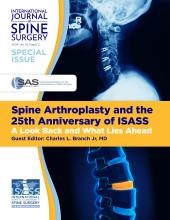ABSTRACT
Background There is a scarcity of research on the Charlson Comorbidity Index (CCI) and its influence on minimum clinically important difference (MCID) achievement after minimally invasive (MIS) transforaminal lumbar interbody fusion (TLIF). The objective of this study is to detail the association between the CCI and attaining MCID after MIS TLIF.
Methods A prospective surgical registry was retrospectively reviewed for spine surgeries between May 2015 and February 2019. Inclusion criteria were primary or revision, 1- or 2-level MIS TLIF procedures. Patients were stratified based on CCI score: 0 points (no comorbidities), 1–2 points (mild CCI), ≥3 points (moderate CCI). Preoperative, intraoperative, and postoperative variables were assessed by subgroup using appropriate statistical analysis. Subgroups were analyzed with linear regression or χ2 tests for continuous or categorical variables, respectively. Subgroup scores, improvement, and MCID achievement were assessed at postoperative timepoints (eg, 6 weeks, 12 weeks, 6 months, and 1 year) for back and leg pain, Oswestry Disability Index (ODI), SF-12 Physical Composite Score (PCS), and Patient-Reported Outcomes Measurement Information System Physical Function (PROMIS PF).
Results A total of 171 patients were included (n = 51 [no comorbidities], n = 73 [mild CCI], and n = 47 [moderate CCI]). Higher CCI patients were older and more likely to be smokers, diabetic, arthritic, hypertensive, or have a malignancy history (P < 0.003). Preoperatively, ODI and PROMIS PF were the only patient-reported outcomes with a significant association by CCI group (P = 0.015 and 0.014). Back pain was the only measure that had a significant association with the CCI subgroup at 1 year for score (P = 0.002) or MCID (P = 0.028).
Conclusions By 1 year, regardless of the number of comorbidities, a similar proportion of patients undergoing MIS TLIF were able to achieve MCID for visual analog scale leg, SF-12 PCS, and PROMIS PF. Patients with higher comorbidities are not likely to experience a significant difference in symptom improvement. Regardless of CCI score, MIS TLIF can have a significant benefit for patients.
Level of Evidence IV.
Clinical Relevance Text.
- minimally invasive transforaminal interbody fusion
- spine surgery
- minimal clinically important difference
- Patient-Reported Outcomes Measurement Information System
- PROMIS
Footnotes
Disclosures and COI: No funds were received in support of this work. No benefits in any form have been or will be received from any commercial party related directly or indirectly to the subject of this manuscript. IRB Approval: ORA No. 14051301.
- This manuscript is generously published free of charge by ISASS, the International Society for the Advancement of Spine Surgery. Copyright © 2021 ISASS







